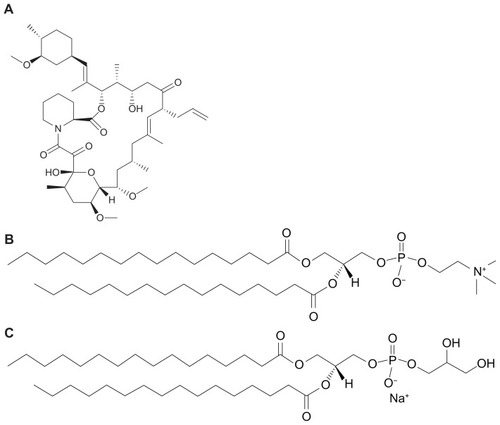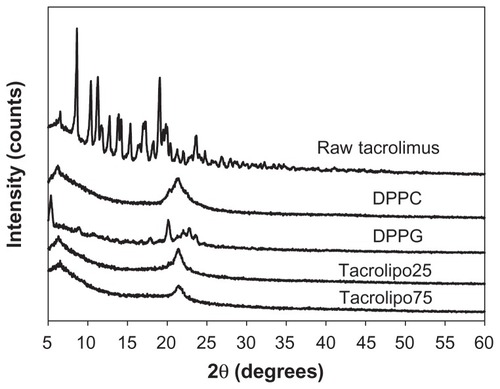Abstract
The aim of this study was to design, develop, and optimize respirable tacrolimus microparticles and nanoparticles and multifunctional tacrolimus lung surfactant mimic particles for targeted dry powder inhalation delivery as a pulmonary nanomedicine. Particles were rationally designed and produced at different pump rates by advanced spray-drying particle engineering design from organic solution in closed mode. In addition, multifunctional tacrolimus lung surfactant mimic dry powder particles were prepared by co-dissolving tacrolimus and lung surfactant mimic phospholipids in methanol, followed by advanced co-spray-drying particle engineering design technology in closed mode. The lung surfactant mimic phospholipids were 1,2-dipalmitoyl-sn-glycero-3-phosphocholine and 1,2-dipalmitoyl-sn-glycero-3-[phosphor-rac-1-glycerol]. Laser diffraction particle sizing indicated that the particle size distributions were suitable for pulmonary delivery, whereas scanning electron microscopy imaging indicated that these particles had both optimal particle morphology and surface morphology. Increasing the pump rate percent of tacrolimus solution resulted in a larger particle size. X-ray powder diffraction patterns and differential scanning calorimetry thermograms indicated that spray drying produced particles with higher amounts of amorphous phase. X-ray powder diffraction and differential scanning calorimetry also confirmed the preservation of the phospholipid bilayer structure in the solid state for all engineered respirable particles. Furthermore, it was observed in hot-stage micrographs that raw tacrolimus displayed a liquid crystal transition following the main phase transition, which is consistent with its interfacial properties. Water vapor uptake and lyotropic phase transitions in the solid state at varying levels of relative humidity were determined by gravimetric vapor sorption technique. Water content in the various powders was very low and well within the levels necessary for dry powder inhalation, as quantified by Karl Fisher coulometric titration. Conclusively, advanced spray-drying particle engineering design from organic solution in closed mode was successfully used to design and optimize solid-state particles in the respirable size range necessary for targeted pulmonary delivery, particularly for the deep lung. These particles were dry, stable, and had optimal properties for dry powder inhalation as a novel pulmonary nanomedicine.
Introduction
Lung transplantation is a widely accepted strategy to treat end-stage pulmonary disease. However, the long-term survival rate after lung transplantation remains low due to the development of bronchiolitis obliterans, which accounts for approximately 30% of deaths.Citation1–Citation3 Bronchiolitis obliterans syndrome (BOS), the physiological manifestation of chronic rejection, is defined as a loss of forced expiratory volume in 1 second of 20% or greater from the individual patient’s maximum post-transplant value.Citation4 BOS and its therapeutic strategies have been recently reviewed by Hayes.Citation5 It most likely represents an immune process having multiple risk factors and can be induced following respiratory infection, as recently reported by Hayes et al.Citation6 The histopathologic features of bronchiolitis obliterans involve injury and inflammation of epithelial cells and subepithelial structures of small airways, leading to excessive fibroproliferation, seemingly due to ineffective epithelial regeneration.Citation7,Citation8
Tacrolimus, a hydrophobic 23-membered macrolide lactone, is one of the most effective immunosuppressive drugs for the prevention of allograft rejection following transplantation of lung.Citation9,Citation10 It is a calcineurin inhibitor, which can disrupt the signaling events mediated by calcineurin in T lymphocytes and consequently inhibit T-cell activation. Tacrolimus (FK506) is a potent immunosuppressive drug marketed as PROGRAF® (Astellas Pharma US, Inc, Northbrook, IL, USA) in a number of countries. It was discovered by Kino and Gotoh of Fujisawa Pharmaceutical Co, in 1984 during a program designed to discover and develop an alternative immunosuppressant to cyclosporine.Citation11 It is a macrocyclic lactone derived from the actinomycete Streptomyces tsukubaensis. Although structurally different from cyclosporine, tacrolimus suppresses the immune system by similar mechanisms to cyclosporine. It binds in the cytoplasm with FK binding proteins and interferes with the signal transduction from T-cell surface receptors to the nucleus in lymphocytes, preventing transcription of lymphokine genes involved in T-cell activation.Citation12–Citation15
Tacrolimus is 50–100 times more potent than the immunosuppressant cyclosporine A in inhibiting T-cell activation.Citation16 In addition to its immunosuppressive effect, tacrolimus can act as an anti-inflammatory or antiallergic agent.Citation17–Citation19 Clinical trials have shown tacrolimus to be an effective alternative to cyclosporine A in reducing risk of acute rejection and obliterative bronchiolitis following lung transplantation. In addition to potency differences between tacrolimus and cyclosporine A, there are mechanistic differences, in that tacrolimus inhibits interleukin (IL)-2-induced IL-5 production by human CD4+ T cells and inhibits T-cell proliferation stimulated by IL-2 and IL-7.Citation20 In addition, tacrolimus has been demonstrated to be effective in treating BOS and improving lung function in lung transplant recipients who develop BOS while taking cyclosporine A.Citation21 However, tacrolimus is a hydrophobic compound and hardly soluble in water (<0.003 mg/mL at 25°C).Citation22 Its bioavailability after oral administration is poor and highly variable (7%–32% in adults and 7%–55% in children). It is almost completely metabolized through the cytochrome P-450 pathway (CYP3A)Citation12 in the liver, with a reported 7.7–15.2 hours in children and 23–46 hours in adults.Citation23
As a result of these pharmacokinetic properties and its extremely narrow therapeutic index, the use of oral tacrolimus is very difficult to manage clinically and requires frequent serum concentration monitoring. The commercially available intravenous dosage form of tacrolimus contains the solubilizing agent polyoxyethylated castor oil, which has been reported to be toxic, so we limit the use of this formulation to a few doses or days of therapy. Systemic side effects such as neurotoxicity and nephrotoxicity complicate the use of tacrolimus in the clinical setting, restricting the permissible dosage.Citation24
To overcome these constraints of tacrolimus, involving systemic side effects and an extremely narrow therapeutic index, local immunosuppression by the inhaled route of administration after lung transplantation is a potential approach to directly target the smaller airways where BOS occurs, with improved bioavailability locally to the lung tissue, minimal to no systemic side effects, and improved pulmonary function, as detailed by Hayes et al.Citation25 Pulmonary inhalation aerosols have demonstrated success in the targeted delivery of a wide array of pulmonary drugs directly and efficiently to the lungsCitation6,Citation25–Citation28 and with high patient acceptance. Cyclosporine A has been aerosolized in human lung transplant patients as a nebulized aerosol solution of cyclosporine A dissolved in propylene glycol.Citation29–Citation31 We have successfully demonstrated in our recent report the improved response in a lung transplant patient to inhaled nebulized tacrolimus for successful lung immunosuppression while significantly reducing systemic side effects, improving pulmonary functions, improving bioavailability locally in the smaller airways where BOS occurs, and improving patient outcomes.Citation25
Pulmonary surfactant is a complex and elegant mixture of specific phospholipids and lung surfactant-specific proteins synthesized and secreted by type II pneumocytes in the lining of the alveoli. The vital role of surfactant in respiration is to decrease the work of breathing by reducing the surface tension to near 0 mN/m at the air-water interface in the lung.Citation32–Citation35 The main constituents of pulmonary surfactant are lipids and lung surfactant-specific proteins, which account for ~90% and 10% of the surfactant mass, respectively.Citation36,Citation37 Of the lipids, ~85%–90% are specific phospholipids, of which ~80% are phosphatidylcholine (PC) and ~10% are phosphatidylglycerol (PG).Citation32,Citation34,Citation35,Citation37,Citation38 The fraction of PC accounted for by dipalmitoylphosphatidylcholine (DPPC), a disaturated 16-carbon acyl chain PC, is 54% in humans.Citation38 Formation of a DPPC-rich monolayer (a nanoflim) at the interface is thought to reduce surface tension, which reduces the work of breathing and thus facilitates respiration. Surfactant physiological effectiveness also depends on the presence of other components, including anionic lipids such as PG, surfactant proteins, and Ca2+. In addition, these lung surfactant mimic phospholipids, DPPC and 1,2-dipalmitoyl-sn-glycero-3-[phosphor-rac-1-glycerol] sodium salt (DPPG), are used in lung surfactant replacement nanomedicine therapies, controlled release drug delivery, and nanomedicine pulmonary delivery.Citation35,Citation39–Citation43
Currently, tacrolimus is delivered to the patient by the oral or intravenous routes. However, these administration routes are associated with severe systemic side effects by lowering the body’s ability to mount an immune response. To fulfil the unmet medical need in minimizing the systemic toxicities, pulmonary inhalation using dry powder inhalers (DPIs) is receiving significant attention, as demonstrated by the increasing number of successful DPI products approved for human use.Citation27,Citation44
The aim of this novel study is to rationally design, comprehensively characterize, and optimize respirable tacrolimus dry powders for targeted deep lung delivery produced for the first time by the novel engineering process of organic solution advanced spray drying in closed mode. As we reported for pulmonary delivery application, the novel particle design process of organic solution advanced spray drying in closed mode was used.Citation45,Citation46 In addition, we report for the first time on the design and optimization of tacrolimus lung surfactant mimic (DPPC/DPPG) multifunctional microparticles and nanoparticles as inhalable dry powders. They are produced by organic solution advanced co-spray drying in closed mode for targeted deep lung nanomedicine delivery in clinical treatment of acute rejection and obliterative bronchiolitis following lung transplantation. Moreover, the effect of the organic solution closed-mode spray-drying process on the physicochemical properties of these novel microparticulate/nanoparticulate DPI formulations was also systematically and comprehensively characterized.
Experimental
Materials
United States Pharmacopeia-grade tacrolimus powder (99.3% purity) was purchased from APAC Pharmaceutical LLC (Columbia, MD, USA) with a molecular weight of 804.02 g/mol (). Synthetic lung surfactant mimic phospholipid powders DPPC and DPPG were purchased from Avanti Polar Lipids, Inc (Alabaster, AL, USA). Their chemical structures are shown in . Methanol (high-performance liquid chromatography grade, also meets American Chemical Society specifications, 0.2 micron filtered) was purchased from Fisher Scientific (Pittsburgh, PA, USA). Special anhydrous AQUA STAR methanol for moisture determinations was purchased from EMD Chemicals, Inc (Darmstadt, Germany). Honeywell Riedel-de Haen® Hydranal®-Coulomat AD, reagent for Karl Fischer (KF) coulometric titration, was purchased from Sigma-Aldrich (St Louis, MO, USA). All powders were stored in tightly sealed glass desiccators over Drierite®/Indicating Drierite® desiccant (W.A. Hammond Drierite Co. Ltd., Xenia, OH, USA) in the freezer at −23°C.
Methods
Preparation of advanced spray-dried tacrolimus and co-spray-dried tacrolimus lung surfactant mimic particles
Solutions containing tacrolimus were prepared with a total powder mass of 1% (w/v) in methanol. The prepared formulations were subsequently spray dried using the Buchi mini spray dryer B-290 with a Buchi high-performance cyclone plus the Buchi inert loop B-295 in closed mode under ultra-high purity (UHP) nitrogen gas (Scott-Gross Company, Inc, Lexington, KY, USA). As stated in , and similar to the advanced spray-drying conditions previously reported by these authors,Citation45,Citation46 the following spray-drying conditions in closed mode were used: inlet temperature 100°C, UHP nitrogen atomizing gas flow 601 L/h, various pump rates rationally selected, and aspirator setting 100%.
Table 1 Advanced spray-drying parameters in closed mode of pump rate, inlet temperature, and outlet temperature in the spray-drying process and resultant particle size of dilute organic solution advanced spray-dried tacrolimus dry powder inhalation particles
Co-spray-dried powders of tacrolimus lung surfactant particles were prepared by dissolving DPPC, DPPG, and tacrolimus simultaneously in methanol with a total powder mass of 1% (w/v) followed by co-spray drying. The molar ratio of DPPC:DPPG was 3:1, as this is the lung surfactant mimic ratio. The advanced co-spray-drying process was operated under the conditions described previously. All spray-dried and co-spray-dried powders were stored in a desiccator in the freezer until analysis.
Particle sizing and size distribution
The volume-based particle size and size distribution performed on dry powders were quantified by the Shimadzu SALD-7101 ultraviolet laser diffraction nanoparticle size analyzer (Shimadzu Scientific Instruments, Inc, Columbia, MD, USA). The measured sample containing dry powder suspended in a dispersant was prepared by mixing approximately 40 mg of dry powder in 10 mL of deionized water in a capped vessel and gently shaking. Tacrolimus is hardly soluble in water (<0.003 mg/mL at 25°C),Citation47 as are the synthetic phospholipids. Therefore, water was chosen as a suitable dispersant. Prior to each volume-based particle size and size distribution measurement, a blank cell filled with deionized water was analyzed for background measurement. Subsequently, about 1.5 mL of the sample containing the dry powder suspended in dispersant was added to the blank, and its volume-based particle size and size distribution were measured. These conditions are similar to those reported previously by these authors.Citation45,Citation48,Citation49
Scanning electron microscopy
Electron microscopy is an important technique in examining dry powder inhalation formulations for respiratory delivery.Citation50,Citation51 The shape and surface morphology of raw unprocessed, spray-dried, and co-spray-dried respirable powders were visualized and examined by scanning electron microscopy (SEM) (Hitachi Model S-800, Hitachi Ltd, Tokyo, Japan). Samples were first prepared by placing a very small amount of powder on to an aluminum specimen stub covered with a double-sided adhesive carbon disc, and then sputter coated (Hummer VI Sputtering System by Technics) with gold prior to imaging. Coating was performed at 20 mA for 3 minutes. These conditions are similar to those reported previously by these authors.Citation45,Citation46,Citation48,Citation49
Thermal analysis
Differential scanning calorimetry (DSC) was performed using the TA DSC Q200 (TA Instruments-Waters LLC, New Castle, DE, USA) equipped with an automated computer-controlled refrigerated cooling system (RSC-90; TA Instruments-Waters LLC), and T-Zero™ technology. Powder samples (3–5 mg) were carefully weighed and placed in T-Zero™ alodined aluminum DSC pans (TA instruments-Waters LLC), which were then hermetically sealed with a T-Zero™ hermetic sealer (TA instruments-Waters LLC). The phase transition temperature melting point (T m) of the samples was measured under a 50 mL/minute dry UHP nitrogen gas (Scott-Gross Company, Inc) purge in DSC. The samples were heated at a rate of 5°C/minute from 10°C–300°C and also at slower scan rates of 2.5°C/minute. At least four melting scans were carried out to ensure T m reproducibility. The measured DSC data were analyzed using a coupled DSC Q200-1740 data station (TA Instruments-Waters LLC). These conditions are similar to those reported previously by these authors.Citation32,Citation34,Citation35,Citation45,Citation46,Citation48,Citation49,Citation52
X-ray powder diffraction
The degree of long-range molecular order (crystallinity) versus disorder (noncrystallinity) for all powders was measured by X-ray powder diffraction (XRPD) using similar conditions reported previously by these authors.Citation45,Citation46,Citation48,Citation49,Citation53 Samples of dry powders were gently placed on to a glass slide (Rigaku Corporation, Tokyo, Japan) to form a level surface. Then the glass slide was placed in the X-ray beam path. The X-ray diffraction instrument (slit-detector system) used was Rigaku X-Ray Diffractometer (Rigaku Corporation) with a Cu source at 44 mA and 40 kV. The scanning range of 5–60 two-theta degrees at room temperature was used at a scanning rate of 2 two-theta degrees per minute at a step rate of 0.04 two-theta degrees.
Cross-polarizing light hot-stage microscopy
Solid-state phase transitions for the powders were observed under a cross-polarizing light hot-stage microscope (HSM) for the presence and/or absence of birefringency using conditions similar to those reported previously by our group.Citation45,Citation46 The digital imaging system consisted of a polarized optical microscope (Olympus BX51; Olympus Corporation, Tokyo, Japan) and a hot stage equipped with a temperature control unit (INSTEC Heater STC200; Instec Inc, Boulder, CO, USA). The microscope was connected to a computer, and SPOT Advanced Software (Diagnostic Instruments, Inc, Sterling Heights, MI, USA) was used to digitally capture pictures from the microscope. The temperature control unit was also connected to a computer, and Advanced WinTemp v 2.00 software (Instec Inc) was used to set up the heating conditions. Powder samples were mounted on a microscope slide and placed into the sample chamber of the hot stage. The powder samples were then heated from 25°C to a final temperature of 300°C at a heating scan rate of 5.00°C/minute.
Karl Fischer coulometric titration
Residual water content in the raw, spray-dried, and co-spray-dried respirable powders was analytically quantified by KF coulometric titration methodCitation45,Citation46 using a KF coulometric titrator (Metrohm 737 KF Coulometer; Metrohm Schweiz AG, Zofingen, Switzerland), equipped with a magnetic stirring device (Metrohm 703Ti Stand; Metrohm Schweiz AG). The KF titrator cell was filled with Honeywell Riedel-de Haen® Hydranal®-Coulomat AD reagent, comprising methanol, diethanolamine, imidazole, hydroiodic acid, and sulfur dioxide. The titration sample was prepared by dissolving 50 mg of powders into 100 mL anhydrous AQUA STAR methanol. Precisely weighed sample solution (~500 mg) was then injected into the KF titrator to react with titration reagent under magnetic stirring. At the end point of titration, the water amount in the analyzed sample was displayed automatically on the titrator. Given that the weight of reacted sample was known, the percentage of water in the sample was calculated.
Gravimetric water vapor sorption
Gravimetric water vapor isotherms were measured gravimetrically using an automated ultrasensitive microelectronic balance (Cahn) coupled to a computerized VTI SGA-CX Symmetrical Vapor Sorption Analyzer (VTI Corp, Hialeah, FL, USA) under dry UHP nitrogen gas vacuum conditions. Conditions employed were similar to those previously reported by these authors.Citation35,Citation45,Citation52 All measurements were made at 25°C using a sample size of 1.5–2.5 mg. Before the absorption step, samples were dried in situ under dry UHP nitrogen gas vacuum conditions. The criterion used to establish drying equilibrium was a weight change of 0.00% in a 10-minute interval. At the end of the drying cycle, the sample was exposed to a sequence of increasing relative humidity (RH) levels starting at 0% RH. Data were logged every 2 minutes or when the weight gain reached 0.01%. Up to a maximum of 3 hours was allowed, which was sufficient to reach absorption equilibrium at each RH level. The criterion used to establish absorption equilibrium was a weight change of less than or equal to 0.03% in a 10-minute interval.
Results
Particle size and size distribution
The particle sizes of spray-dried tacrolimus particles are shown in . The mean diameter of organic solution advanced spray-dried tacrolimus particles ranged from 1.29 μm to 1.62 μm, which is suitable for targeted inhalation delivery as dry powders. In particular, particles in this size range can effectively target and reach the deep bronchiolar and alveolar regions.Citation27,Citation39,Citation40,Citation44,Citation45,Citation54,Citation55 The size distributions for the various batches were narrow and unimodal. These results indicate that the spray-drying pump rate influences the size of spray-dried particles. Increasing the pump rate of drug solution resulted in a larger particle size. The results also indicate that when the inlet temperature, spray gas flow rate, and aspirator percentage of the spray-drying process remained constant, different pump rates resulted in different outlet temperatures, as shown in .
lists the compositions and particle size of co-spray-dried tacrolimus lung surfactant mimic powder formulations. In laser diffraction particle size analysis, the average size of co-spray-dried tacrolimus lung surfactant mimic particles was found to be 2.46 μm and 2.55 μm, as tabulated in . In particular, particles in this size range can effectively target and reach the deep bronchiolar and alveolar regions.Citation27,Citation39,Citation40,Citation44,Citation45,Citation54,Citation55 The size distributions for the various batches were narrow and unimodal. The average particle size for the various batches did not show a significant difference.
Table 2 Compositions and average particle size of tacrolimus lung surfactant mimic dry powder inhalation formulations by advanced co-spray drying from organic solution in closed mode
SEM
The SEM micrographs of tacrolimus before and after spray drying are shown in . The raw unprocessed tacrolimus particles have very large dimensions and a broad size distribution. The organic solution advanced spray-dried tacrolimus contains spherical particles with a relatively smooth surface, which are two essential particle properties for inhalation delivery of dry powders.Citation45,Citation55,Citation56 The particle size observed in their SEM images is in agreement with that measured by laser diffraction.
Figure 2 Scanning electron micrographs of (A) raw unprocessed tacrolimus, (B) spray-dried tacrolimus prepared at 10% pump rate, (C) spray-dried tacrolimus prepared at 25% pump rate, (D) spray-dried tacrolimus prepared at 50% pump rate, and (E) spray-dried tacrolimus prepared at 75% pump rate.
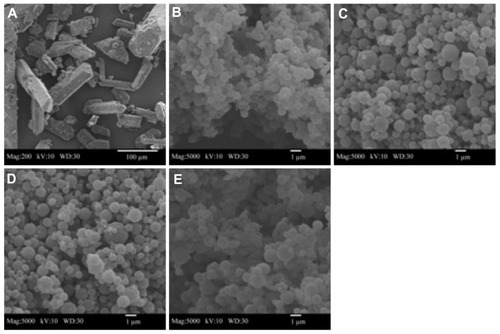
The SEM micrographs of raw tacrolimus and tacrolimus particles are shown in . The organic solution advanced co-spray-dried tacrolimus lung surfactant mimic particles () successfully formed with equivalent sphere particle morphology with a corrugated surface morphology, which are two essential particle properties for inhalation delivery of dry powders. The particle size observed by SEM is in excellent agreement with that measured by laser diffraction.
Thermal analysis by DSC
The thermograms of raw tacrolimus and organic solution advanced spray-dried tacrolimus are shown in . Analysis of the thermogram for raw tacrolimus showed one sharp endothermic peak with an onset temperature at 134°C, indicative of melting and the crystalline nature of the raw unprocessed drug, which was confirmed by XRPD. DSC thermal analysis of the spray-dried powders did not exhibit the characteristic endothermic melting peak, suggesting a loss of crystallinity into a noncrystalline form (likely amorphous) following the organic solution advanced spray-drying process.
Figure 4 Differential scanning calorimetry thermograms at 5.00°C/minute heating scan rate of raw tacrolimus and organic solution advanced spray-dried tacrolimus for dry powder inhalation.
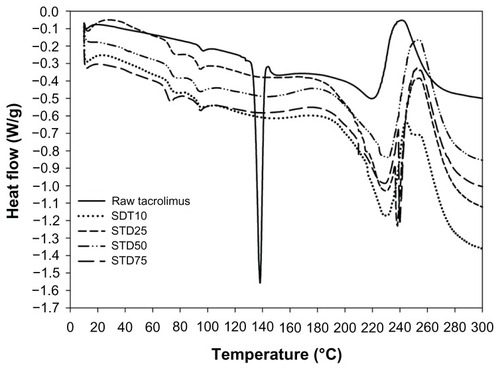
The thermograms of raw tacrolimus and organic solution advance co-spray-dried lung surfactant mimic powders are shown in . DPPC powders exhibit two endothermic phase transitions at 66.9°C and 73°C, corresponding to the gel-to-ripple bilayer pretransition and to the bilayer main transition T m (ie, due to the hydrophobic acyl chain melting event) between the rippled-gel and liquid crystalline phases, respectively.Citation52 DPPG powders showed three endothermic phase transitions consisting of two low-enthalpy pretransitions at ~55.3°C and ~79.5°C and a high-enthalpy main phase transition at 125°C, which correspond to the crystal-to-gel bilayer phase transition, gel-to-ripple bilayer phase transition, and rippled-to-liquid crystalline bilayer main phase transition (T m), respectively.Citation52 Co-spray-dried samples of tacrolipo25 and tacrolipo75 containing lung surfactant mimic DPPC/DPPG (3:1) exhibit the main bilayer phase transition temperature at 66.2°C and 67.4°C, respectively, which are slightly below the T m values of pure DPPC and DPPG powders. All co-spray-dried lung surfactant mimic particles did not exhibit the characteristic tacrolimus endothermic melting peak, suggesting a loss of crystallinity in tacrolimus following organic solution advanced spray drying.
Figure 5 Differential scanning calorimetry thermograms at 5.00°C/minute heating scan rate of raw tacrolimus, pure dipalmitoylphosphatidylcholine (DPPC), pure sodium dipalmitoylphosphatidylglycerol (DPPG), and organic solution advanced co-spray-dried lung surfactant mimic inhalable particles (tacrolipo25 and tacrolipo75) for dry powder inhalation.
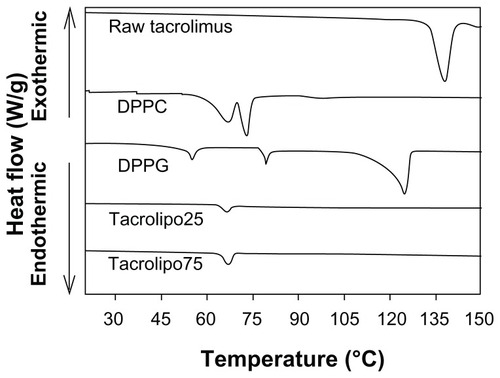
XRPD
Diffractograms for raw and spray-dried tacrolimus at different pump rates are shown in . Raw tacrolimus reveals sharp and narrow diffraction peaks at 5–30 two-theta degrees, which are characteristic of a high degree of long-range molecular order (ie, crystallinity). In contrast, the diffractograms of spray-dried tacrolimus powders lack any significant sharp peaks, which are indicative of the loss in long-range molecular order, which along with thermal analysis suggests formation of the amorphous state. Such observations further confirm the crystallinity in commercial raw tacrolimus and the amorphous state in the organic solution advanced spray-dried tacrolimus powders.
Figure 6 X-ray powder diffractograms of raw tacrolimus and organic solution advanced spray-dried tacrolimus for dry powder inhalation.
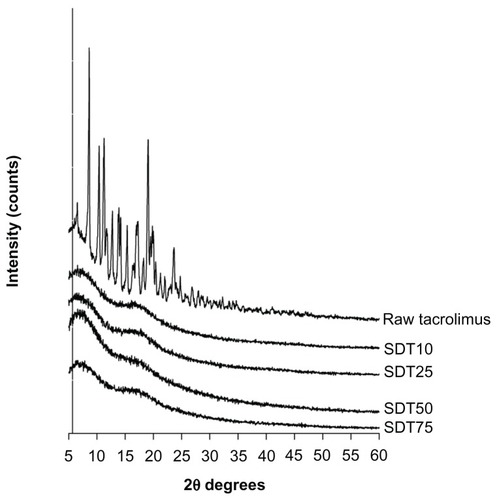
Diffractograms for the co-spray-dried respirable powders are shown in . Raw tacrolimus (highest curve) reveals apparent diffraction peaks at 5–30 two-theta degrees. DPPC and DPPG show a distinct peak in the range of 20–25 two-theta degrees, which is a characteristic range indicative of the phospholipid bilayer structure.Citation57 This characteristic peak is also clearly evident in the co-spray-dried respirable powders, which indicate preservation of the phospholipid bilayer structure in these co-spray-dried powders.
Cross-polarizing light HSM
shows the polarized optical microscope images for the phase transitions of raw tacrolimus. At room temperature, raw tacrolimus exhibited crystal forms, as shown in . When temperature increased to 133.8°C, tacrolimus started to melt (). The onset temperature coincided with its melting recorded by DSC. shows the melting process. Before tacrolimus transformed into a liquid state, it also displayed a liquid crystal state, as shown in . The endothermic peak of crystalline transformation into liquid crystal was also present in the DSC thermograph of tacrolimus at slow heating scan rates of 2.50°C/minute versus 5.00°C/minute, as shown in . At 2.50°C/minute and 5.00°C/minute, DSC thermograms show a small endothermic peak at ~147°C following the main phase transition, indicative of the liquid crystal state. This is the first time that such a thermal event in tacrolimus has been reported. However, interestingly, the small peak was not readily observed at a heating scan rate of 10.00°C/minute. This indicates that only a slow scan rate of 2.50°C/minute can reveal this important liquid crystalline material property involved in the phase transition of crystalline tacrolimus. shows the liquid state of tacrolimus after melting. At 225°C, tacrolimus started to degrade (), which was consistent with the DSC thermal analysis ().
Figure 8 Cross-polarized light optical microscope images of the phase transitions for raw tacrolimus. The samples were heated from 25°C to 300°C at 5.00°C/minute. The temperature for each graph is (A) 24.9°C, (B) 133.8°C, (C) 137.1°C, (D) 139.3°C, (E) 140.9°C, (F) 142.8°C, (G) 150.3°C, and (H) 300.0°C.
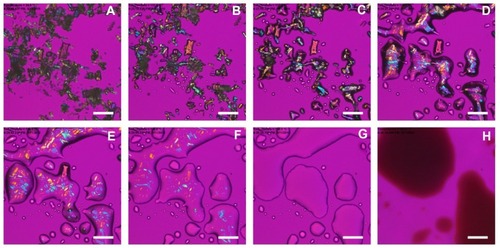
Figure 9 The effect of scanning rate on differential scanning calorimetry (DSC) thermograph of raw tacrolimus.
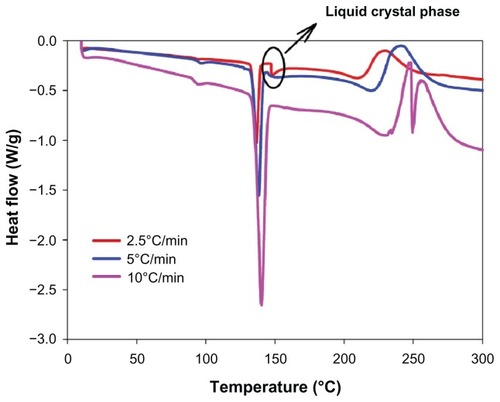
shows the cross-polarized optical microscope images for the phase transitions of organic solution advanced spray-dried tacrolimus. Various spray-dried batches generated similar images. Hence, representative images from the spray-dried tacrolimus prepared at 50% pump rate powders are shown here. As expected, no melting point was observed, which was consistent with the amorphous nature of these respirable tacrolimus spray-dried particles. At ~120°C, tacrolimus existed as a liquid (), and at ~300°C it degraded (), which is consistent with the DSC thermal analysis ().
Figure 10 Cross-polarized light optical microscope images for the phase transitions of spray-dried tacrolimus prepared at 50% pump rate. The samples were heated from 25°C to 300°C at 5°C/minute. The temperature for each graph is (A) 25°C, (B) 85.1°C, (C) 92.1°C, (D) 94.1°C, (E) 98.6°C, (F) 100.6°C, (G) 120.4°C, and (H) 300.0°C.
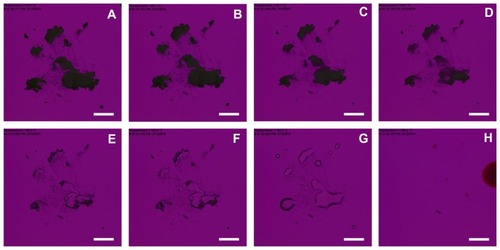
KF coulometric titration
The residual water content in raw unprocessed tacrolimus versus organic solution advanced spray-dried tacrolimus powder at different pump rates were quantified analytically by KF and are shown in . The water content before spray drying was very low at ~1.84% for the raw unprocessed tacrolimus, which is consistent for a hydrophobic drug. Following advanced spray drying from organic solution, the residual water content remaining was successfully reduced remarkably even further to <0.7%. This is well within recommended levels for respirable dry powders for superior aerosolization and enhanced stability.
Table 3 Water content (w/w%) of tacrolimus before and after organic solution advanced spray drying
As shown in , before spray drying, the water content of raw DPPC and DPPG powders was ~1.95% and 0.51%, respectively. After organic solution advanced co-spray drying, the residual water content was successfully reduced even further to ~1%. Again, this is well within recommended levels for respirable dry powders for superior aerosolization and enhanced stability.
Table 4 Water content (w/w%) of tacrolimus, lung surfactant mimic phospholipids, and spray-dried powder inhalation formulations before and after organic solution advanced co-spray drying
Gravimetric water vapor sorption
As shown in , when the RH level exceeded just 20%, which is a low RH level, raw tacrolimus did not absorb any additional water vapor (ie, a plateau is reached at ~20% RH and remains relatively constant thereafter), due to its crystalline nature. This is a characteristic property of crystalline powders. This plateau value is also in excellent agreement with the KF value for raw tacrolimus powder. Contrastingly, the spray-dried powders do not exhibit a significant plateau region over any RH range, and continue to take up more water vapor at RH levels of 90% and higher under equilibrium conditions, which is characteristic of amorphous powders.
Figure 11 Gravimetric water vapor absorption isotherms for raw tacrolimus versus organic solution advanced spray-dried dry powder inhalation tacrolimus at various spray-drying pump rates.
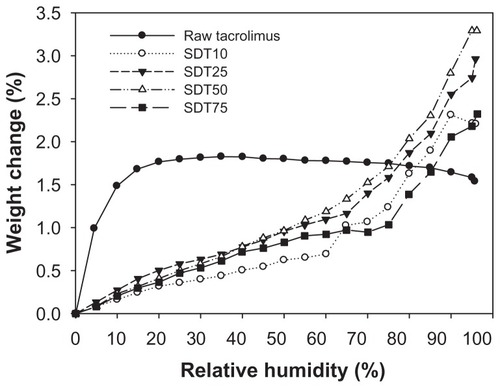
As shown in , at low RH levels of 0%–20% RH, the absorption profiles were similar for DPPC, raw tacrolimus, tacrolipo25, and tacrolipo75. Sodium DPPG absorbed much less water, due to its tightly packed bilayer as a result of favorable electrostatic interactions between the cationic sodium ion and anionic polar headgroup, and is in good agreement with our earlier report.Citation52 At intermediate RH regions, the weight change percentage of DPPG showed a plateau, with an increasing RH between 20%–70%, but increased significantly when the RH exceeded ~70%. The plateau region is indicative of a phase transition, as has been described earlier by these authors.Citation52 A similar profile was observed for DPPC. When RH was between 20% and 65%, the percentage weight change of DPPC was higher than DPPG and is in good agreement with our earlier report.Citation52 When RH level exceeded ~65%, the percentage weight change of DPPC increased significantly with an increasing RH and is in good agreement with our earlier report.Citation52 For the organic solution advanced co-spray-dried tacrolipo25 and tacrolipo75 respirable lung surfactant mimic powders, the profiles were similar to each another and approached the raw DPPC absorption curve when the RH level exceeded ~70% RH.
Figure 12 Gravimetric water vapor absorption isotherms for raw tacrolimus, pure dipalmitoylphosphatidylcholine (DPPC), pure sodium dipalmitoylphosphatidylglycerol (DPPG) and organic solution advanced co-spray-dried lung surfactant mimic particles of tacrolimus for dry powder inhalation (tacrolipo25 and tacrolipo75).
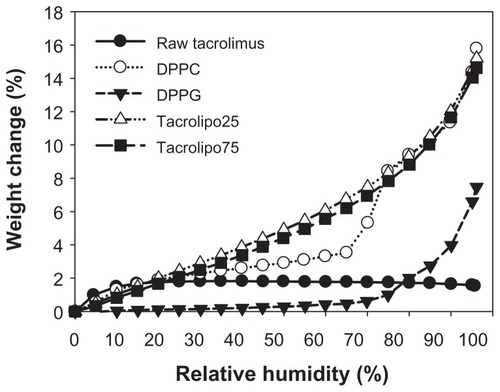
The maximal absorption percentage weight change values at the RH levels found in the lung of 90% and 93% are shown in . This is the maximal water percentage absorbed by the respirable powders and is relatively low, as would be expected for hydrophobic powders.
Table 5 The maximal weight change percentages by water absorption at 90% and 93% RH for raw materials and organic solution advanced spray-dried tacrolimus lung surfactant mimic particles for dry powder inhalation
Discussion
Clinical treatment of acute rejection and obliterative bronchiolitis in lung transplant recipients by systemically administrated tacrolimus has proven to be ineffective, perhaps due to poor penetration into the lung in high enough therapeutic concentrations, as well as limitations of treatment by severe systemic toxicity. We have successfully demonstrated in our recent report the improved response in a lung transplant patient to inhaled nebulized tacrolimus for lung immunosuppression while significantly reducing systemic side effects, increasing local drug concentration in the smaller airways where BOS occurs, improving pulmonary function, and improving patient outcomes.Citation25 The goal of this work was to rationally design dry powder inhalation delivery systems for localized tacrolimus therapy of the lung. We have also successfully developed a tacrolimus formulation with lung surfactant mimic phospholipids (DPPC and DPPG), which can offer lung surfactant replacement therapy, enhanced pulmonary immunity, and sustained release of drug. These formulations are biodegradable and biocompatible. However, rendering nanoparticles may potentially increase tacrolimus blood concentrations following aerosolization, due to possible translocation out of the lung to the blood.
Spray drying is the most commonly used method to prepare powders for inhalation.Citation58,Citation59 It was utilized for preparation and stabilization of particles with desirable properties for pulmonary administration to overcome constraints associated with the lyophilization technique, such as formation of hard cake, need of micronization, addition of coarse carriers for aerosolization, and heterogeneous size distribution pattern. Spray-drying parameters play an important role in DPI properties such as particle size, shape, topographical features, density, and moisture content.
DPIs also offer many important advantages in targeted pulmonary delivery, as described in depth by these authors.Citation26,Citation27,Citation44,Citation51,Citation54,Citation55 The deposition site in the respiratory tract and the performance of inhaled aerosols are influenced by the physicochemical properties of the inhaled particles, including particle size, size distribution, particle morphology, surface morphology, and residual water content.Citation27,Citation44,Citation51,Citation55 Inhaled particles with a particle size in the range of 1–5 μm can efficiently target the deep lung region.Citation39,Citation60,Citation61 To optimize or tailor the particle characteristics in the solid state, the operating parameters of the spray-drying process, such as solvent type (organic or aqueous), solute concentration, atomization pressure, feed properties, pump rate, gas type, gas flow rate, and drying temperature (inlet or outlet), can be modified.Citation39,Citation62 In this study, it is noticed that altering the pump rate resulted in a difference in the particle size (all respirable) and particle surface morphology.
Novel organic solution advanced spray-dried particles and co-spray-dried lung surfactant mimic liposphere particles all were successfully designed under our rationally chosen advanced spray-drying closed-mode conditions with particle size far below 5.0 μm, and all were unimodal with a narrow size distribution. This is the first report of such novel respirable particles for dry powder inhalation for lung immunosuppression. The morphology of the raw materials and the spray-dried particles was investigated, and the SEM micrographs illustrate that processing the solutions of tacrolimus by spray drying yielded spherical particles with the essential properties for inhalation delivery as DPIs. In our novel advanced organic solution spray-drying method, methanol was used to solubilize the drug as a dilute solution, which lowers the final particle size and also lowers the residual water content in the final respirable powders, which, in turn, enhances aerosol performance. Interestingly, all organic solution advanced spray-dried tacrolimus respirable particles were close to a spherical shape (ie, equivalent sphere particle morphology), but their surface morphology could be tailored based on the pump rate chosen.
Raw tacrolimus exhibited distinct characteristic peaks in XRPD diffractograms and melting peak in DSC thermograms, suggesting the crystal nature of the drug. After spray drying, the above peaks were not present in their corresponding graphs, indicating a change from the crystalline state to the amorphous state. These phase transitions were also observed by cross-polarizing light HSM. The loss of crystallinity in spray-dried tacrolimus is expected to enhance its bioavailability, as it has been reported that the pharmaceuticals that have lower crystallinity often resulted in higher solubility and bioavailability.Citation51,Citation63
Novel respirable tacrolimus lung surfactant mimic particles as DPIs of acceptable size and aerosol characteristics were successfully prepared by organic solution advanced co-spray drying a solution of tacrolimus, DPPC, and DPPG. To modify or optimize the particulate product characteristics, advantage can be taken of the operating parameters of the spray-drying process, such as atomization pressure, feed properties, feed rate, gas flow rate, and drying temperature (inlet or outlet).Citation62 Low pump rates (eg, 10%, 25%, and 50%) generated respirable tacrolimus particles with a corrugated surface, whereas a high pump rate (eg, 75%) yielded respirable particles with a relatively smooth surface. Theoretically, particles with a slightly rough surface can improve particle aerodynamic features by increasing air drag force and reducing particle interactions.Citation64–Citation66 Therefore, a pump rate at 50% was used to successfully design and produce respirable tacrolimus lung surfactant mimic particles with corrugated surface for targeted deep lung delivery as DPIs.
In addition to the surface modification of particles, the residual water content of the powders is influenced by the spray-drying conditions. This is another advantage in our rationale in selecting organic solution (alcohol) spray drying in closed mode using UHP nitrogen gas. The residual water content in tacrolimus and DPPC powders before spray drying was significantly higher than that in organic solution advanced co-spray-dried tacrolimus particles.
DSC thermal analysis was used to investigate the effect of preparation process on the thermotropic phase transitions of tacrolimus and lung surfactant phospholipids. It was found that raw materials exhibited apparent T m and other phase transition enthalpy, indicative of their crystalline nature. Interestingly, the thermogram for the developed formulations showed an absence of corresponding endotherm for tacrolimus, and is suggestive of the amorphous nature of tacrolimus in developed formulations. This was also reflected in their corresponding XRPD diffractograms. The phospholipid bilayer structure was preserved for all liposphere DPI formulations following organic solution co-spray drying, as confirmed by both DSC and XRPD.
Conclusion
In this study, we report for the first time that novel respirable tacrolimus particles as DPI formulations for pulmonary nanomedicine were rationally designed, successfully produced, and optimized by organic solution advanced spray drying and co-spray drying in closed mode from dilute alcohol solutions. The particle size, particle morphology, surface morphology, and residual water content of all of the spray-dried and co-spray-dried particles were suitable for targeted respiratory drug delivery as DPIs. There were also changes of physical characteristic states after processing, according to the XRPD and DSC analysis. Spray drying of drug solution caused the loss of crystallinity in tacrolimus powders. It also resulted in a significant reduction of water content. Tacrolimus lung surfactant mimic particles consisting of synthetic lung surfactant phospholipids, DPPC and DPPG, were also rationally designed and optimized for pulmonary nanomedicine delivery as respirable dry powders by advanced organic solution co-spray drying in closed mode. Preservation of the phospholipid bilayer structure in the solid state in the inhalable powders was successfully achieved. The small particle size, unimodal narrow size distribution, particle morphology, surface morphology, and very low residual water content of co-spray-dried particles were all suitable for targeted deep lung respiratory drug delivery. These novel tacrolimus DPI formulations offer great potential in effectively improving the delivery of immunosuppressive drugs directly to the pulmonary tract of lung transplant patients while significantly reducing their systemic side effects.
Acknowledgments
Dr Dicky Yu (UK College of Agriculture) is thanked for SEM access. Dr Tonglei Li (UK College of Pharmacy) is thanked for XRPD and HSM access. Ms Linda Combs is thanked for assistance with proofing and editing.
Disclosure
The authors report no conflicts of interest in this work.
References
- Trulock EP Christie JD Edwards LB Registry of the International Society for Heart and Lung Transplantation: twenty-fourth official adult lung and heart-lung transplantation report-2007 J Heart Lung Transplant 2007 26 8 782 795 17692782
- Taylor DO Edwards LB Boucek MM Registry of the International Society for Heart and Lung Transplantation: twenty-fourth official adult heart transplant report-2007 J Heart Lung Transplant 2007 26 8 769 781 17692781
- Boehler A Estenne M Post-transplant bronchiolitis obliterans Eur Respir J 2003 22 6 1007 1018 14680094
- Estenne M Maurer JR Boehler A Bronchiolitis obliterans syndrome 2001: an update of the diagnostic criteria J Heart Lung Transplant 2002 21 3 297 310 11897517
- Hayes DJr A review of bronchiolitis obliterans syndrome and therapeutic strategies J Cardiothorac Surg 2011 6 92 1 9 21208441
- Hayes DJr Mansour HM Kirkby S Phillips AB Rapid acute onset of bronchiolitis obliterans syndrome in a lung transplant recipient after respiratory syncytial virus infection Transpl Infect Dis 2012 1 3
- Yousem SA Berry GJ Cagle PT Revision of the 1990 working formulation for the classification of pulmonary allograft rejection: Lung Rejection Study Group J Heart Lung Transplant 1996 15 1 Pt 1 1 15 8820078
- Halloran PF Homik J Goes N The “injury response”: a concept linking nonspecific injury, acute rejection, and long-term transplant outcomes Transplant Proc 1997 29 1–2 79 81 9123164
- Knoop C Haverich A Fischer S Immunosuppressive therapy after human lung transplantation Eur Respir J 2004 23 1 159 171 14738248
- Kobashigawa JA Patel J Furukawa H Five-year results of a randomized, single-center study of tacrolimus vs microemulsion cyclosporine in heart transplant patients J Heart Lung Transplant 4 2006 25 4 434 439 16563974
- Briffa N Morris RE New immunosuppressive regimens in lung transplantation Eur Respir J 1997 10 11 2630 2637 9426106
- van den Berg JW Postma DS Koeter GH van der Bij W New immunosuppressive drugs and lung transplantation: last or least? Thorax 1999 54 6 550 553 10335012
- Wiederrecht G Lam E Hung S Martin M Sigal N The mechanism of action of FK-506 and cyclosporin A Ann N Y Acad Sci 1993 696 9 19 7509138
- Siekierka JJ Sigal NH FK-506 and cyclosporin A: immunosuppressive mechanism of action and beyond Curr Opin Immunol 1992 4 5 548 552 1384551
- Rondeau E Mechanism of action of the new immunosuppressants: cyclosporin A, FK 506 and rapamycin Nephrologie 1992 13 3 137 1379348
- Kino T Hatanaka H Hashimoto M FK-506, a novel immunosuppressant isolated from a Streptomyces. I. Fermentation, isolation, and physico-chemical and biological characteristics J Antibiot (Tokyo) 1987 40 9 1249 1255 2445721
- Keicho N Sawada S Kitamura K Yotsumoto H Takaku F Effects of an immunosuppressant, FK506, on interleukin 1 alpha production by human macrophages and a macrophage-like cell line, U937 Cell Immunol 1991 132 2 285 294 1703047
- Sakr MF McClain CJ Gavaler JS Zetti GM Starzl TE Van Thiel DH FK 506 pre-treatment is associated with reduced levels of tumor necrosis factor and interleukin 6 following hepatic ischemia/reperfusion J Hepatol 1993 17 3 301 307 7686193
- Clardy J The chemistry of signal transduction Proc Natl Acad Sci U S A 1995 92 1 56 61 7529414
- Almawi WY Melemedjian OK Clinical and mechanistic differences between FK506 (tacrolimus) and cyclosporin A Nephrology, Dialysis, Transplantation 2000 15 12 1916 1918
- Borro J Bravo C Solé A Conversion from cyclosporine to tacrolimus stabilizes the course of lung function in lung transplant recipients with bronchiolitis obliterans syndrome Transplant Proc 2007 39 7 2416 2419 17889206
- Canadas O Guerrero R Garcia-Canero R Orellana G Menendez M Casals C Characterization of liposomal tacrolimus in lung surfactant-like phospholipids and evaluation of its immunosuppressive activity Biochemistry 2004 43 30 9926 9938 15274647
- Taketomo C Hodding J Kraus D Pediatric Dosage Handbook 16th ed Hudson, OH American Pharmacists Association 2009 1173
- Kur F Reichenspurner H Meiser BM Tacrolimus (FK506) as primary immunosuppressant after lung transplantation Thorac Cardiovasc Surg 1999 47 3 174 178 10443520
- Hayes DJr Zwischenberger JB Mansour HM Aerosolized tacrolimus in a lung transplant recipient Transplant Proc 2010 42 9 3876 3879 21094875
- Park CW Hayes DJr Mansour HM Pulmonary inhalation aerosols for targeted antibiotics drug delivery. invited paper European Pharmaceutical Review 2011 16 1 32 36
- Hickey AJ Mansour HM Chapter 5: delivery of drugs by the pulmonary route Florence AT Siepmann J Modern Pharmaceutics 5th ed New York Taylor and Francis, Inc 2009 2 191 219
- Patton JS Byron PR Inhaling medicines: delivering drugs to the body through the lungs Nat Rev Drug Discov 2007 6 1 67 74 17195033
- Iacono AT Corcoran TE Griffith BP Aerosol cyclosporin therapy in lung transplant recipients with bronchiolitis obliterans Eur Respir J 2004 23 3 384 390 15065826
- Niven R Toward managing chronic rejection after lung transplant: the fate and effects of inhaled cyclosporine in a complex environment Adv Drug Deliv Rev 2011 63 1–2 88 109 20950661
- Corcoran TE Inhaled delivery of aerosolized cyclosporine Adv Drug Deliv Rev 2006 58 9–10 1119 1127 16997418
- Mansour H Wang DS Chen CS Zografi G Comparison of bilayer and monolayer properties of phospholipid systems containing dipalmitoylphosphatidylglycerol and dipalmitoylphosphatidylinositol Langmuir 2001 17 21 6622 6632
- Morrow MR Temple S Stewart J Keough KM Comparison of DPPC and DPPG environments in pulmonary surfactant models Biophys J 2007 93 1 164 175 17434940
- Mansour HM Zografi G Relationships between equilibrium spreading pressure and phase equilibria of phospholipid bilayers and monolayers at the air-water interface Langmuir 2007 23 7 3809 3819 17323986
- Mansour HM Damodaran S Zografi G Characterization of the in situ structural and interfacial properties of the cationic hydrophobic heteropolypeptide, KL4, in lung surfactant bilayer and monolayer models at the air-water interface: implications for pulmonary surfactant delivery Mol Pharm 2008 5 5 681 695 18630875
- Goerke J Pulmonary surfactant: functions and molecular composition Biochim Biophys Acta 1998 1408 2–3 79 89 9813251
- Veldhuizen R Nag K Orgeig S Possmayer F The role of lipids in pulmonary surfactant Biochim Biophys Acta 1998 1408 2–3 90 108 9813256
- Postle AD Heeley EL Wilton DC A comparison of the molecular species compositions of mammalian lung surfactant phospholipids Comp Biochem Physiol A Mol Integr Physiol 2001 129 1 65 73 11369534
- Mansour HM Rhee YS Wu X Nanomedicine in pulmonary delivery Int J Nanomedicine 2009 4 299 319 20054434
- Mansour HM Rhee YS Park CW DeLuca PP Lipid nanoparticulate drug delivery and nanomedicine Moghis A Lipids in Nanotechnology 1st ed Urbana, IL American Oil Chemists Society (AOCS) Press 2011 221 268
- Mansour HM Park CW Hayes DJr Nanoparticle lung delivery and inhalation aerosols for targeted pulmonary nanomedicine Kumar A Mansour HM Friedman A Blough E Nanomedicine in Drug Delivery London, UK CRC Press/Taylor Francis Inc 2013 In press
- Rhee YS Mansour HM Nanopharmaceuticals I: nanocarrier systems in drug delivery. Invited paper Int J Nanotechnol 2011 8 1–2 84 114
- Wu X Mansour HM Nanopharmaceuticals II: application of nanoparticles and nanocarrier systems in pharmaceutics and nanomedicine. Invited paper Int J Nanotechnol 2011 8 1–2 115 145
- Hickey AJ Mansour HM Formulation challenges of powders for the delivery of small molecular weight molecules as aerosols Rathbone MJ Hadgraft J Roberts MS Lane ME Modified-Release Drug Delivery Technology 2nd ed New York Informa Healthcare 2008 2 573 602
- Li X Mansour HM Physicochemical characterization and water vapor sorption of organic solution advanced spray-dried inhalable trehalose microparticles and nanoparticles for targeted dry powder pulmonary inhalation delivery AAPS PharmSciTech 2011 12 4 1420 1430 22038473
- Meenach SA Vogt FG Anderson KW Hilt JZ McGarry RC Mansour HM Design, physicochemical characterization, and optimization of organic solution advanced spray-dried inhalable dipalmitoylphosphatidylcholine (DPPC) and dipalmitoylphosphatidylethanolamine poly(ethylene glycol) (DPPE-PEG) microparticles and nanoparticles for targeted respiratory nanomedicine delivery as dry powder inhalation aerosols Int J Nanomedicine 2013 8 275 293 23355776
- Canadas O Guerrero R Garcia-Canero R Orellana G Menendez M Casals C Characterization of liposomal tacrolimus in lung surfactant-like phospholipids and evaluation of its immunosuppressive activity Biochemistry 2004 43 30 9926 9938 15274647
- Xu Z Mansour HM Mulder T McLean R Langridge J Hickey AJ Dry powder aerosols generated by standardized entrainment tubes from drug blends with lactose monohydrate: 2. Ipratropium bromide monohydrate and fluticasone propionate J Pharm Sci 2010 99 8 3415 3429 20222025
- Mansour HM Xu Z Hickey AJ Dry powder aerosols generated by standardized entrainment tubes from alternative sugar blends: 3. Trehalose dihydrate and D-mannitol carriers J Pharm Sci 2010 99 8 3430 3441 20229601
- Park CW Rhee YS Vogt F Advances in microscopy and complementary imaging techniques to assess the fate of drugs ex-vivo in respiratory drug delivery. Invited Paper Adv Drug Deliv Rev 2012 64 4 344 356 21920394
- Hickey AJ Mansour HM Telko MJ Physical characterization of component particles included in dry powder inhalers. I. Strategy review and static characteristics J Pharm Sci 2007 96 5 1282 1301 17455324
- Mansour HM Zografi G The relationship between water vapor absorption and desorption by phospholipids and bilayer phase transitions J Pharm Sci 2007 96 2 377 396 17080427
- Xu Z Mansour HM Mulder T McLean R Langridge J Hickey AJ Dry powder aerosols generated by standardized entrainment tubes from drug blends with lactose monohydrate: 1. Albuterol sulfate and disodium cromoglycate J Pharm Sci 2010 99 8 3398 3414 20198688
- Willis L Hayes DJr Mansour HM Therapeutic liposomal dry powder inhalation aerosols for targeted lung delivery Lung 2012 190 3 251 262 22274758
- Wu X Li X Mansour HM Surface analytical techniques in solid-state particle characterization: implications for predicting performance in dry powder inhalers. Invited paper KONA Powder and Particle Journal 2010 28 3 19
- Xu Z Mansour HM Hickey AJ Particle interactions in dry powder inhaler unit processes J Adhes Sci Technol 2011 25 4–5 451 482
- Alves GP Santana MHA Phospholipid dry powders produced by spray drying processing: structural, thermodynamic and physical properties Powder Technol 2004 145 139 148
- Andya JD Maa YF Costantino HR The effect of formulation excipients on protein stability and aerosol performance of spray-dried powders of a recombinant humanized anti-IgE monoclonal antibody Pharm Res 1999 16 3 350 358 10213364
- Sollohub K Cal K Spray drying technique: II. Current applications in pharmaceutical technology J Pharm Sci 2010 99 2 587 597 19862804
- Yu J Chien YW Pulmonary drug delivery: physiologic and mechanistic aspects Crit Rev Ther Drug Carrier Syst 1997 14 4 395 453 9450176
- Schulz H Mechanisms and factors affecting intrapulmonary particle deposition: implications for efficient inhalation therapies Holger Schulz Pharm Sci Technol Today 1998 1 8 326 344
- Master L Spray Drying Handbook 5th ed New York Longman 1991
- Li DX Oh YK Lim SJ Novel gelatin microcapsule with bioavailability enhancement of ibuprofen using spray-drying technique Int J Pharm 2008 355 1–2 277 284 18243606
- Chew NY Chan HK Use of solid corrugated particles to enhance powder aerosol performance Pharm Res 2001 18 11 1570 1577 11758765
- Chew NY Tang P Chan HK Raper JA How much particle surface corrugation is sufficient to improve aerosol performance of powders? Pharm Res 2005 22 1 148 152 15771241
- Maa YF Costantino HR Nguyen PA Hsu CC The effect of operating and formulation variables on the morphology of spray-dried protein particles Pharm Dev Technol 1997 2 3 213 223 9552449
